The most major artery through Greenwich Village is Bleecker Street, which stretches from The Bowery in the east to Eighth Avenue in the West Village. But Bleecker Street is more than a thoroughfare, it’s central to New York’s story as a cultural powerhouse, a breeding ground for artists, poets, gangsters, musicians, and politicians. That’s what makes it one of the best streets in New York City to explore on foot and this guide identifies key buildings and sites along the way that have contributed to the rich tapestry of history that has been woven between the east and west sides of Greenwich Village.

Bleecker Street is named after Anthony Lispenard Bleecker, a wealthy landowner, merchant, auctioneer, banker and vestryman, and warden for the Trinity Church in the Financial District. Bleecker’s farm covered this area, and the street harks back to when it ran along the northern edge of his land between Bowery and Broadway. His son, a founder of the New-York Historical Society and a literary contemporary of Washington Irving bequeathed the area to the city.
Strangely, Bleecker Street has grown over the years, stretching beyond its original few blocks to overtake what was formerly David Street, Herring Street, and Carroll Place. Today on the portion of the street that was Carroll Place there is a bar of the same name and the street starts at The Bowery – the farm end, eventually winding up to Hudson Street, close to the river.
It’s from the Bowery end of Bleecker that we’ll walk on this digital guided tour.
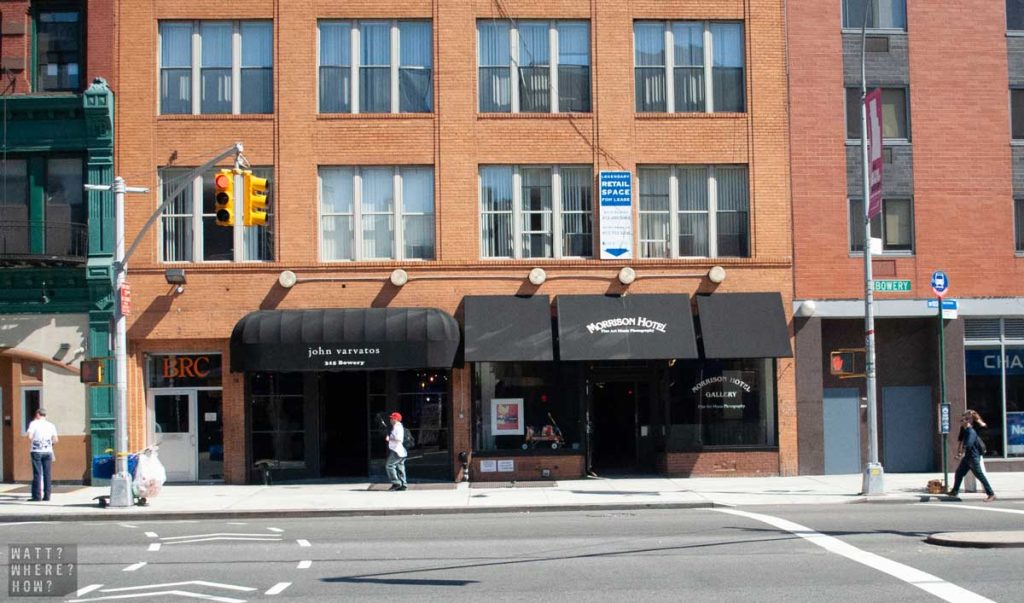
Bleecker & The Bowery: CBGBs
Not officially on Bleecker Street but positioned at the end of it across the road on Bowery is the site of the famed CBGBs. Operated by Hilly Kristal from 1973, it was a rowdy, inclusive venue for local musicians, with its moniker standing for Country Blue Grass Blues & Other Music For Uplifting Gourmandizers. After 1974, it became renowned for different music, but not on the country, blues, or bluegrass end of the spectrum. It sparked a scene of groundbreaking bands that became the biggest of their generation: Television, The Ramones, Talking Heads, Blondie, and later many of the most brutal NYHC (New York Hard Core) bands.

CBGBs closed its doors in 2006 and its iconic black awning is now housed in the Rock and Roll Hall of Fame in Cleveland. The venue has been replaced by the flagship store for rock-leaning fashion designer, John Varvatos, who has tried to preserve elements of the original venue, with its walls covered in plexiglass to display the last era of gig flyers pasted layer upon layer of past band promos. There’s a stage with a backline of classic amps and from time to time, he hosts showcase, invitation-only events – a far cry from the sweaty, sticky floors, and notoriously fetid toilets.

Crossing The Bowery to the start of Broadway, a large mural covers the walls outside of Saxon and Parole, a popular restaurant and brunch joint. In the past, it had a mural dedicated to Joey Ramone, while more recently, a piece dedicated to Blondie was painted by Shepard Fairey.

7 Bleecker Street
Number 7 was built in 1816 by James Roosevelt, FDR’s great grandfather. Swiss documentary photographer Robert Frank lived on-premises until his death in 2019.
9 Bleecker Street: Overthrow
Number 9 is a classic NYC boxing gym, Overthrow, but in the 80s, it was the headquarters of activists, the Yippies, the Youth International Party. Also, of interest is that this 1884 Renaissance Revival building was designed by Frederick C. Withers, who was also responsible for the Jefferson Market Courthouse on Sixth Avenue.
10 Bleecker Street: Formerly Studio 10
While CBGBs’ biggest bands were heading towards mega stardom, it was little venues like Studio 10 that were becoming the proving ground for the next wave of New York punks like Bad Brains and DOA.

45 Bleecker Street: Lyn Redgrave Theater.
The Lyn Redgrave Theater is an off-Broadway stage on the NoHo (North of Houston Street) end of Bleecker Street. Billed as “New York’s premier home for socially conscious theatre”, it has featured performances by Alec Baldwin, Sarah Jones, Desmond Tutu, Mariska Hargitay, Trevor Noah, and Vanessa and Corin Redgrave.

51 Bleecker Street: PaperTiger.TV/Kith
The corner of Bleecker and Lafayette is a headquarters for activists PaperTiger.TV but it’s also housed the War Resisters League, earning the building the name, the Peace Pentagon. The complete antithesis of the activist spirit is the KITH store on the ground floor. This is a popular sneaker store that holds regular drops of exclusive name brand sneakers, attracting queues of Gen Zs camping out around the block.
54 Bleecker Street: formerly the Noho Star
A popular haunt for celebs and fashion publishers, the Noho Star helped ingrain the term, which is short for the area North of Houston Street. It closed in December 2017.
58 Bleecker Street: The Bleecker Bar
Another popular New York dive haunt, it’s deceptively bigger inside, with a back room of billiard tables and dart boards. The building was once owned by Franklin D. Roosevelt’s great-great-grandfather.

65 Bleecker Street – the Bayard-Condict Building
While New York is the birthplace of the skyscraper, the Bayard-Condict Building was part of the evolution of engineering that led to its inception. The only property in Manhattan by the “father of skyscrapers” and “father of modernism”, Louis Sullivan, it was one of the first steel-frame skeletons, though you’d never realize as it’s clad in the most intricate and ornate white terra cotta. The flagship Le Pain Quotidien bakery dominates the street front, with its community tables and cooking classes.
Bleecker and Broadway
On the northeast corner of Bleecker and Broadway, directly adjacent to the Bayard-Condict Building is the Manhattan Savings Institution (MSI) building, which dates back to 1890 and was designed by Stephen Decatur Hatch.

Bleecker: Mercer to La Guardia Place
Once across Mercer Street, Bleecker Street changes considerably as the blocks between here and La Guardia Place have been modernized completely. Once Little France, a cluster of old apartment tenements, the earlier buildings were demolished to make way for the Washington Square Village and Silver Towers apartment towers for New York University residences and the New York University Fitness Center, which is currently being rebuilt to include gyms, tennis courts, and a pool. The two saving graces are the green spaces of real grass and oak trees, and a concrete sculpture that architect I.M. Pei commissioned from Pablo Picasso, an enlarged version of his 1934 Bust of Sylvette and realized by Norwegian sculptor Carl Nesjär.
GMT Tavern


144 Bleecker Street: Formerly the Bleecker Street Cinema
Like so much of New York City, classic venues have been taken over by chains like in this case, the site of the Bleecker Street Cinema and Mori Italian Restaurant. Today’s it’s a Duane Reade pharmacy, but the columns are all that remain of the restaurant that was onsite from the 1880s to 1930.
147 Bleecker Street: The Bitter End
The Bitter End opened in 1961 and it’s one of the only early 1960s venues that both remain in the same place and that remains true to its original vision of helping up and coming musicians to break into the New York scene and beyond. At its height, there were appearances by Stevie Wonder, Miles Davis, Pete Seeger, Bob Dylan, Billy Joel, Patti Smith, Neil Diamond, Linda Ronstadt, Etta James, Simon and Garfunkel, and most recently, Lady Gaga, who performed for a small audience of promotion winders as part of the Bud Light dive bar tour, and then reappeared with her band up on the awning for another “locals only” set for those who couldn’t get in. The venue is also immortalized on live albums by Peter, Paul, and Mary, Dion, and Pete Seeger.

145 Bleecker Street: The Peculier Pub
Like Wicked Willy’s, the Peculier Pub (their misspelling) is a frattish dive with a high quotient of NYU students. It boasts a menu of 350 different bottled beers and 27 beers on draught. Inside, the stained glass windows and pew seating are remnants of the bar that stood in its place 30 years ago, Preachers, and before that, it was a bar called The Dug Out and before that, it was a bible store – who Peculier! Novelist James Fenimore Cooper lived in this building from 1833-35.

149 Bleecker Street: Terra Blues and Wicked Willy’s
At 149 Bleecker is a tale of two extremes and generations. Upstairs is acclaimed venue, Terra Blues, while at street level is the binge and purge, pirate-themed NYU student dive bar, Wicked Willy’s. Terra Blues opened over 20 years ago and is a favorite for blues purists, attracting performances from artists like Slam Allen, Bobby Radcliff, and Clarence Spady.
At the opposite end of the class-ometer is the pirate den of ill-repute that is Wicked Willy’s. Parked outside is a six-person pedal bike dressed in palm fronds, skeletons, and slogans like “Time flies when you’re having rum”. On big nights, it rides around the area picking up those keen for a boozy good time, Shanghai’ing them to the bleach and vomit scented dark wood bar for cheap happy hour beer and shot deals.

151 Bleecker Street: The Red Lion
Self-proclaimed British pub, The Red Lion doesn’t feel British at all inside. The closest it gets is the multiple LCD screens tuned to soccer games and the ability to get a pint of ale. Instead, it’s a rowdy bar with performances from excellent cover bands which always makes for a fun night on the turps. The mural on the Thompson Street wall is by Brooklyn artist, Jonathan Fritz.

152 Bleecker Street: The former site of Café Au Go Go
One of the most famous venues in Greenwich Village folklore was Café Au Go-Go. It was here that comedian, Lenny Bruce was arrested for obscenity while performing his razor-sharp stand-up and between ’64 and ’69, it hosted shows featuring The Grateful Dead, Hendrix, and a young George Carlin. Upstairs was the New Andy Warhol Garrick Theatre, but sadly the building was demolished in 1970, replaced by nondescript apartments, and today, an Indian restaurant and a Capital One bank.
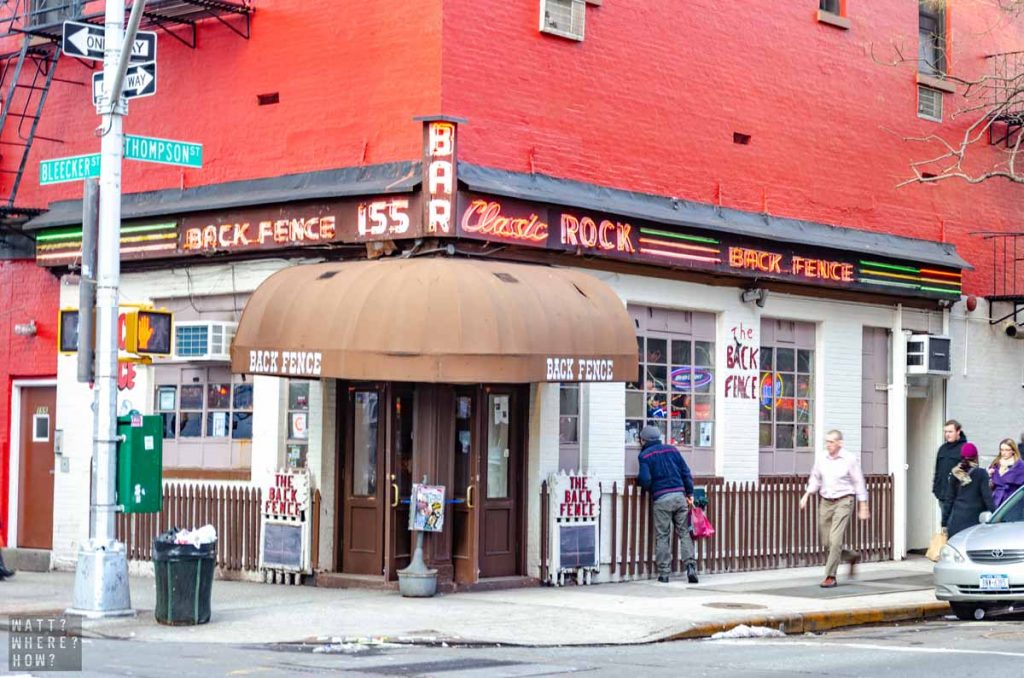
155 Bleecker Street: Formerly The Back Fence
This corner shopfront at the intersection of Thompson Street has been many things in the last eight years, including a pork BBQ restaurant, but prior to its closure in 2013, it was a boisterous live venue, The Back Fence which was open since 1945.
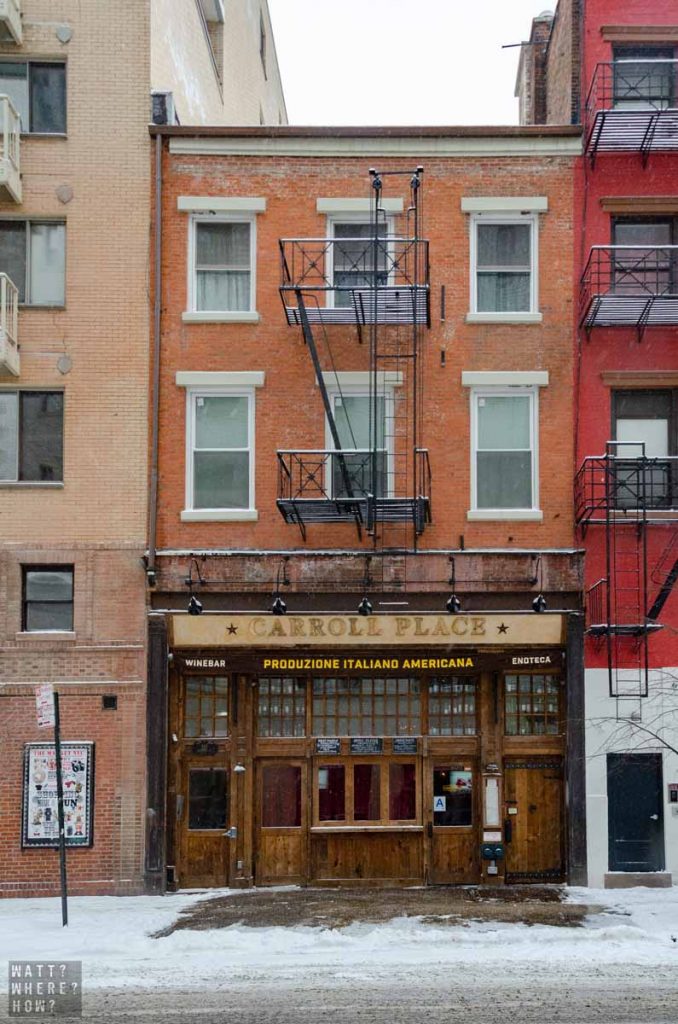
157 Bleecker Street: Carroll Place
This building housed the rock venue, Kenny’s Castaways until 2012. Gigs over its time included Bruce Springsteen, Patti Smith, the New York Dolls. Today it’s Carroll Place, a popular bar and brunch venue.
158 Bleecker Street: La Poisson Rouge
Though part of the massive building that is Mills House No.1, La Poisson Rouge (LPR) is its own world, a modern club and live venue in the basement. It attracts major and lesser-known acts and is often used for press and showcases by acts like the Kings of Leon.

159 Bleecker Street
The awning for the old Circle In The Square Theatre is all that remains of the off-Broadway venue that occupied the space from 1960 to 1972. In recent years, the premises has been home to a craft market, and now, it’s space for a design agency.

160 Bleecker Street – Mills House No.1 and formerly The Village Gate
The Mills Hotel was a men’s hostel built in 1892 by Ernest Flagg and financed by banker, Darius Ogden Mills to service poor New York men. It contained 1,554 rooms (7 and a half by 6 feet or 5 by 8 feet) that were not much more than a cell but could be rented for 20cents a night with a meal costing 15cents more.
From 1958 to 1994, the renowned Greenwich Village club, the Village Gate was in the basement. In recent years, Mills House No.1 has been gut renovated into deluxe apartments that bear no resemblance to its tenement past. There’s no longer the venue, instead a CVS pharmacy takes the space, but the original signage for The Village Gate has been preserved on the Thompson Street side of the building. In 1973, the Village Gate hosted National Lampoon Lemmings – a stage show that launched the careers of Chevy Chase, Christopher Guest, Gilder Radner, Bill Murray, and Harold Ramis – some of the hugest comedy stars of Saturday Night Live and renowned for their roles in major late 1970s and 1980s movies from Animal House to Ghostbusters.
165 Bleecker Street: Fiore’s Pizza
In a city of pizza shops, Fiore’s doesn’t necessarily rise above, but it’s always faithful and the owner is a New York firefighter who served on 9/11.
167 Bleecker Street: The Village Lantern
On street level, it’s a basic dive bar with comedy in the backroom, while downstairs is a basement comedy club. It was known as Mondo Perso is the early 90s and attracted gigs from Blues Traveller and the Spin Doctors.

Walking past on most nights, it’s not uncommon to be accosted by young comedians offering tickets to a free comedy show. Known as “yellers”, they’re usually the freshest talent, who if they sell enough tickets, earn themselves a spot on the billing. It’s not actually free as there is a two-drink minimum and in some cases, they’ll pass around the hat for tips. Let the drinks flow and the laughs usually follow, making for an unpredictable, but usually fun night out.
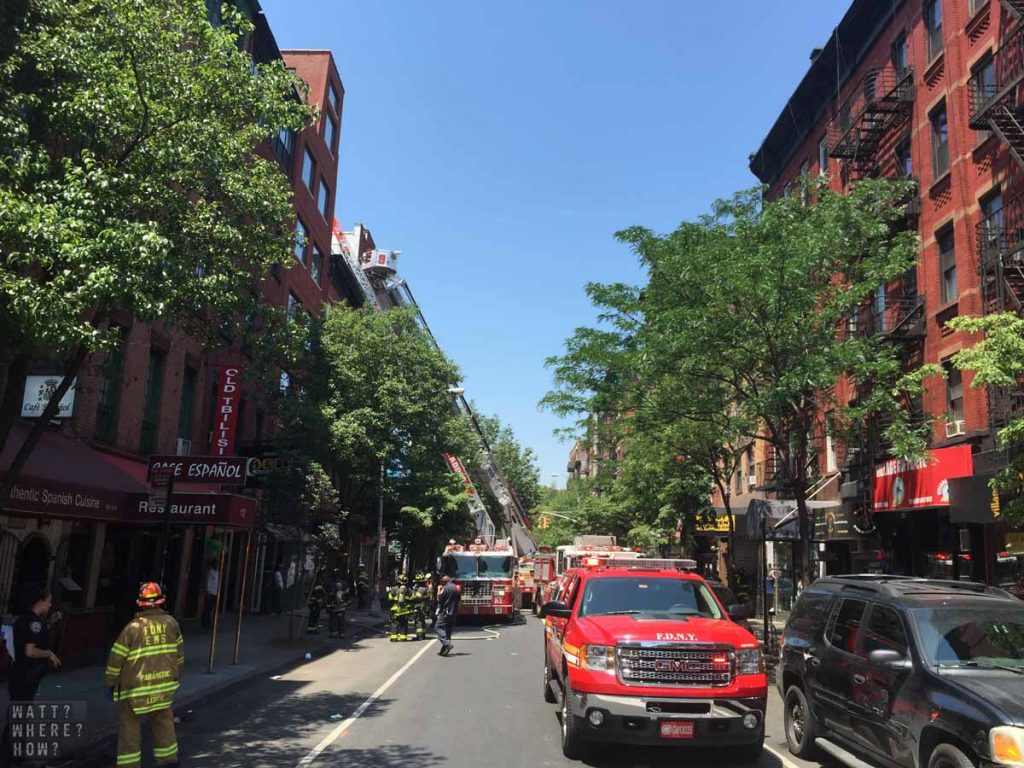
172 Bleecker Street: Cafe Espanol
In an apartment above Cafe Espanol, writer James Agee, a village resident from 1941 to 1951 wrote the screenplay for The African Queen.
173 Bleecker Street: Village Tannery
For the last 47 years, the Village Tannery has been situated on this stretch between Sullivan and MacDougal Streets. It’s a traditional tannery, with the hide sourced from upstate farms and the bags crafted onsite completely by hand.
177A Bleecker Street
For comic nerds familiar with the Marvel universe, 177A is the address of Dr. Strange’s Sanctum Sanctorum.

184-186 Bleecker Street: Formerly Café Le Figaro
The southeast corner of Bleecker and MacDougal was Café Le Figaro, a venue that boasted regulars like Jack Kerouac, Lenny Bruce, and Bob Dylan in its heyday from 1957 to 69, though it was operational up until 2008 and you can still spot branding on the first floor awnings and an imprint of the name in bronze in the pavement on the corner.

185 Bleecker Street: By Chloe
This ornate Beaux-Arts tenement building built in 1904 was Cafe Borgia for sixty years, which in the fifties and sixties attracted beatniks, artists, and stars from Andy Warhol to James Dean. Today it’s a popular vegan café/restaurant By Chloe.

189 Bleecker Street: Formerly Café San Remo
Porto Rico Importing (coffees and teas) has been in business since 1907
Minetta Lane/Street
Minetta Street is a historic back street for African Americans, being the site of 19th Century Little Africa, a community serviced by its own church and theater nearby. The street follows the line of a brook, the Minetta (Dutch for small stream Mintje Kill), which has now been relegated to nothing but a subterranean sewerage pipeline that flows onwards to around 8th Street. I once read that the watercourse was responsible for occasional flooding at Electric Lady Studios when Jimi Hendrix first opened it and they needed to use a bilge pump to contain the impact.

By the late 19th Century, Little Africa had been overtaken by Italian migrants and had descended into a slum of tenements. Mexican restaurant, Panchito’s open since 1972 took over its lease from what was formerly the Fat Black Pussycat Theater which is where Bob Dylan first read “Blowin In The Wind” in 1962. Up until 2011, the faded sign for the theater was still visible over the bright red facade, but it was painted over by Panchito’s. The restaurant is used as a shooting location for shows like The Black List, Girls, and Crashing. Another Fat Black Pussy Cat of lesser note exists on West 3rd Street.
Minetta Street also features in many movies and TV shows and its apartments are now mostly luxurious addresses for wealthy New Yorkers. It intersects with Minetta Lane, a short street between Macdougal Street and Sixth Avenue, on which stands an off-Broadway theater and the famous Minetta Tavern.
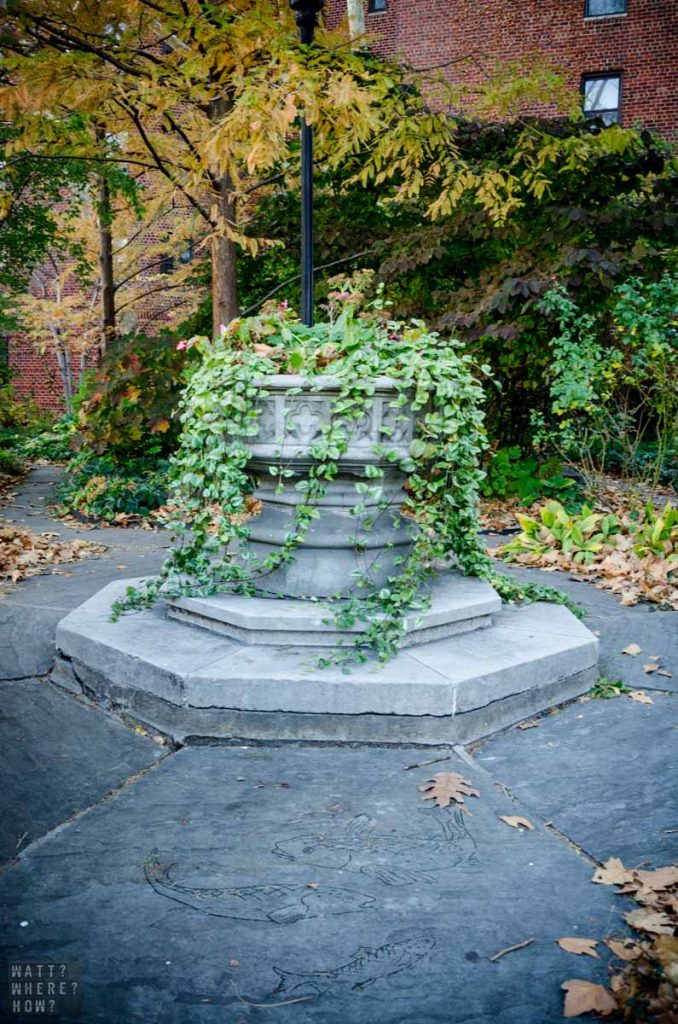
Minetta Triangle
Before you cross the avenue, there is another tiny park at 6th Avenue and Bleecker and Minetta Streets, Minetta Triangle also designed by Vellonaki – who is also the person who redesigned Washington Square Park to reposition the fountain. Bordering Minetta Street, the park has fish carved into its steps, a nod to what once ran through here and the neighboring street – a tiny brook.
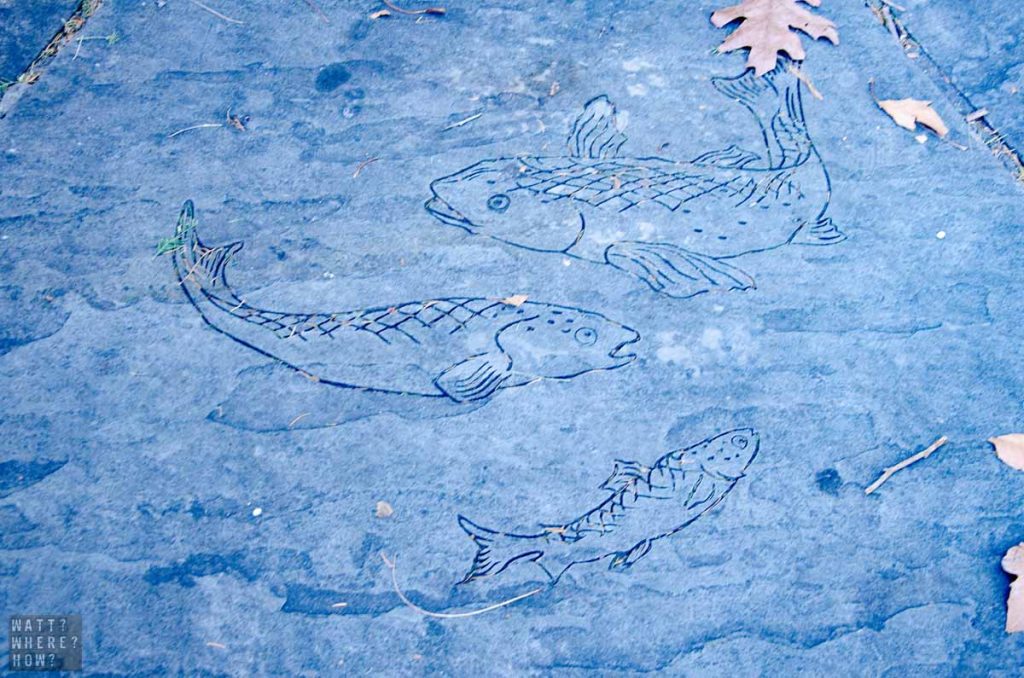

West Village Wanderings
This section of Greenwich Village marks the shift to West Village in terms of naming conventions and in this stretch between Carmine and Seventh Avenue, it’s where are a large proportion of Italian migrants lived before it attracted young professionals and up-and-coming actors.
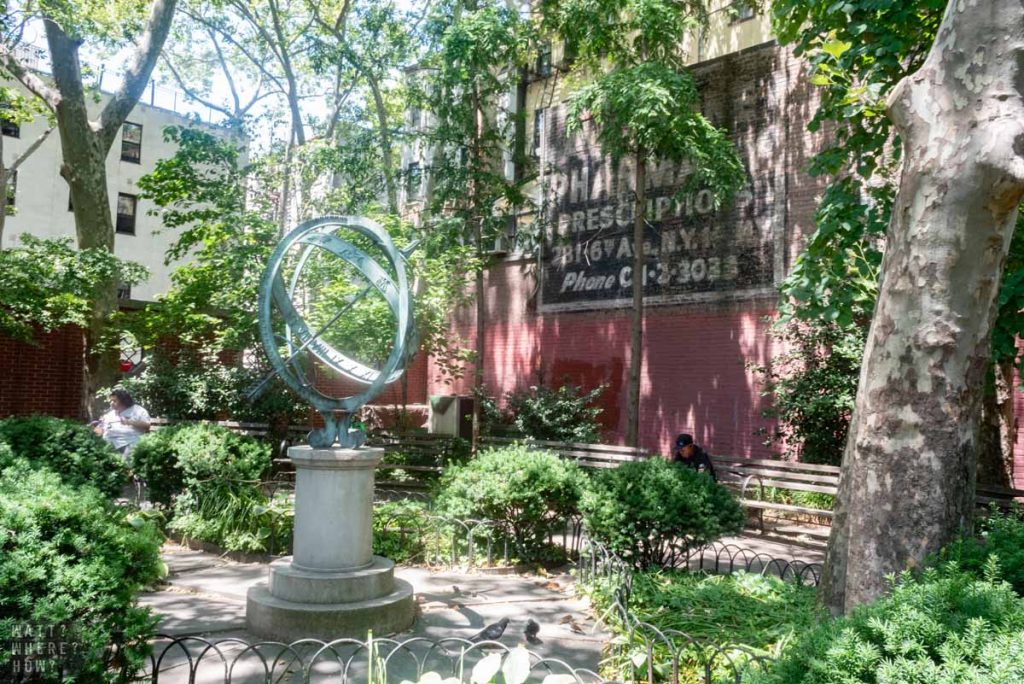
Bleecker and Downing: Churchill Square
Once across the Avenue of the Americas (6th), there’s a cute park at 6th Avenue, Bleecker, and Downing Streets called Churchill Square. The paved area and gardens designed by George Vellonaki can be a peaceful place to pause, with its red brick walls leading into an adjoining playground, though it’s also popular with homeless folks. The neighboring Avignone Chemists were recently replaced by a Sweetgreen Salads chain store.

Father Demo Square
Father Demo Square is a public park formed at Sixth, Bleecker and Carmine with a simple fountain and seating. Sitting diagonally to Our Lady of Pompeii church, it was named by Mayor Fiorello LaGuardia in 1936 in honor of Father Antonio Demo who bought the land at Bleecker and Carmine for the church which replaced St. Benedict the Moor black catholic church after it was demolished to make way for the construction of the IND subway line.
237 Bleecker Street: GROM
The simple two-story house on the northeast corner of Bleecker and Carmine dates to 1822 and has GROM gelateria, a popular European brand of ice cream as its current tenant. On hot summer days, there’s always a queue.

At the southwest corner of Bleecker and Carmine stands a beautiful old red brick building that was forever the Trattoria Spaghetto (or at least since 1990 – but it closed last year). The whole block was bought by venture capitalists who “surprise surprise” upped the rent on everyone and has brought in chain restaurants – it’s what’s rapidly killing the Village. Note the old dark blue Bleecker Street sign on the wall.
237 Bleecker Street
Despite selling the latest in mobile phone 5g tech, 237 Bleecker Street is a wood frame coach house that was built in 1830. It and neighboring 233 Bleecker are two of the oldest wooden frame structures in Manhattan still standing.
239-253 Bleecker Street
Like much of the Village, this stretch has predominantly replaced earlier traders with chains like Starbucks, but if you look up above the signage, it’s a series of traditional row houses built in 1830. 239 was the home of Bleecker Street Records which moved to West 4th Street before finally closing its doors in the last few years. One snowy morning in a blizzard, I stopped in at the Starbucks and a part of the wall panel was revealed for some unknown reason – and I was pleasantly surprised to find some original yellowing gig posters from the early 1980s glued to the wall.

240 Bleecker Street: Our Lady of Pompeii Church and School
Our Lady of Pompeii was constructed in 1928 in the Romanesque Revival style, replacing an older church that was in the path of the IND Subway construction.

254 Bleecker Street: Murray’s Cheese Shop
Murray’s Cheese Shop is a must-visit stop on any Greenwich Village walking tour. It was opened in 1940 by Spanish Civil War veteran Murray Greenberg and has grown into a success story for its extensive range of artisanal cheeses, charcuterie, and delicatessen products.
259 Bleecker Street: Formerly Zito’s Bakery
While not the original façade, you may notice the blue and white tiling and stained glass above the doorway of what was once Zito’s Bakery which was open for over 80 years until its doors closed in 2004. Today, it’s Baker & Co., an Italian restaurant specializing in seafood and pasta made fresh in-house.
260 Bleecker Street: Faicco’s Italian Specialties.
Original Faicco, Eduardo emigrated from Sorrento to New York City in 1900 and opened a butcher’s shop on Elizabeth Street, relocating to Thompson Street and finally to the current location in the early 1950s. Today, this deli is still run by members of the Faicco family.
262 Bleecker Street: Trattoria Pesce Pasta
The colorful red awning and façade of this cute trattoria were once enhanced by the bright colored Federal rowhouses built for Charles Oakley in 1833. Today, the section between Leroy and Morton streets has been painted almost identically, taking away a little color and character from Bleecker Street. The trattoria has been a tenant since 1993 and boasts traditional Sicilian fish and pasta dishes as its specialty.

264 Bleecker Street: Murray’s Cheese Bar
As a plus-up from the normal cheese shop experience, you can quaff Italian wines, cheeses and sweet biscuits.

266 Bleecker Street: Formerly BookBook
For as many years as we can remember, BookBook stood in this location and before that, it was located on the corner further up which is now BookMarc by Marc Jacobs. It would tease with its cheap tables of loss leaders on the sidewalk and then entice with its quality selection of literature and art and design tomes within.

273 Bleecker Street: Formerly Matt Umanov’s Guitars
It’s not greedy landlords that spelled the end of Matt Umanov’s Guitars, it was just a desire to retire at the age of 70. His first shop was nearby on Bedford, which he opened in 1969, when the village was at its swinging, rocking, folking peak. The Bleecker location operated from 1982 to 2017 and was a regular haunt for me. Other more illustrious customers included Bob Dylan and Eric Clapton.


278 Bleecker Street: John’s of Bleecker Street
When people ask, “what’s the best pizza in New York?” most people will drop the name John’s in their top five. There are better pies out there, but this one’s part of the fabric of the city and top of mind due to its convenient location. Opened in 1929 by John Sasso, its windows and walls are covered in promo photos and autographs of the celebrities who have dined there over the years. The Port’Alba neon signage is from an earlier restaurant he owned. Another quirk of the place is that it’s 100% full pie only – no cheap slices here.
280 Bleecker Street: Formerly Fish
For many years, Fish was packed with locals and college kids seeking out its crazy-cheap lobster and seafood delights, washed down with PBR cans.
281 Bleecker Street: The Blind Tiger
From the outside, The Blind Tiger looks like a seedy dive, but that belies its hidden treasures inside if you’re a fan of craft beers and microbrews. Apparently, the decor within has been sourced from a 19th-century farmhouse.

285 Bleecker Street: Ottomanelli & Sons
Another business with a Bleecker Street shopfront from its days as an Italian enclave is S. Ottomanelli & Sons. Opened in 1930, by two immigrants from Bari on Italy’s east coast, Gennaro Ottomanelli initially sold meats from a pushcart on the street from 1900 but partnered with his brother Salvatore to launch the physical shop. Back in the 1950s, they’d deliver meats to Arthur Miller and Marilyn Monroe. In recent years, one of the Ottomanelli sons forever sullied the family name after handing an African American delivery driver a noose and offering to help him use it. That’s enough of a reason not to want to drop in.

The Caliente Cab Company
Dominating the corner of Seventh and Bleecker and with a hard to miss giant margarita suspended off its exterior and a vintage yellow cab parked alongside, The Caliente Cab Company is a Mexican restaurant that is garish, loud, and fun with its frozen cocktails and cheap eats making it a hot spot – albeit for those with low standards and light wallets.
On the east side of the road is Bleecker Street Pizza, a humble-looking place that has been named New York’s 2nd best pizza by travelers on Tripadvisor.
296 Bleecker Street: Five Guys and The Garret
Crossing 7th Avenue at the corner of Barrow and Bleecker Street is Five Guys Burgers and Fries, which has become famous enough to be franchised internationally. Yes, the burgers are good, but what most visitors miss is The Garret, a cocktail bar hidden on the next floor up that serves exclusive Five Guys burgers.
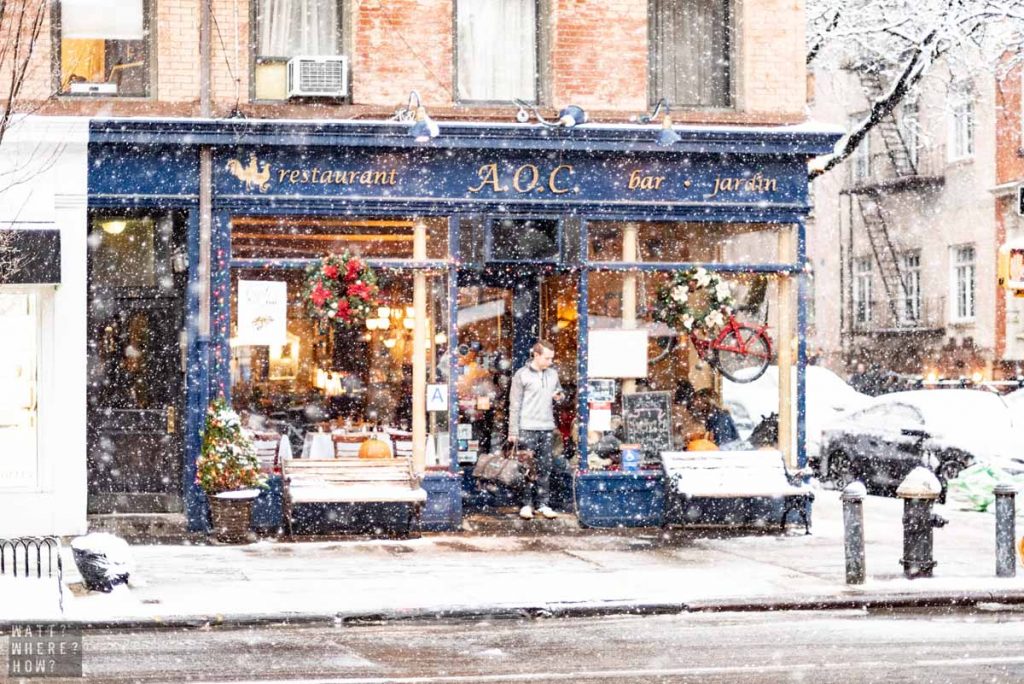
A.O.C., formerly The Grove is one of the few restaurants in the area with outdoor dining (well at least pre-COVID, as now everyone offers outdoor dining to survive).
309 Bleecker Street: Thomas Paine’s House
A plaque at 309 Bleecker Street commemorates Thomas Paine, an activist who wrote and distributed the pamphlets, “The Crisis” and “Common Sense” in favor of American independence from Great Britain. He was also involved in the French Revolution during the Reign of Terror where he was arrested and jailed. While in the cells, he wrote “The Age of Reason”. Paine lived his last years off Bleecker on Grove Street and though the building is long gone, the boisterous basement cabaret and musical theatre bar, Marie’s Crisis is named in honor of his writings.
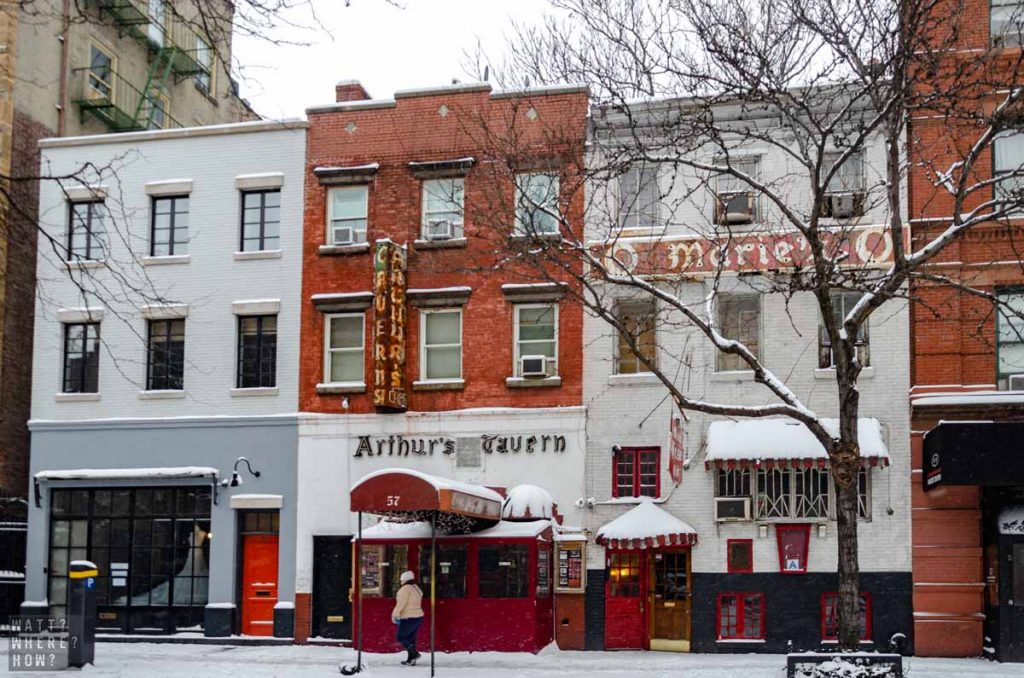
319 Bleecker Street
A delightful detail to look out for on the six story brick building on the corner of Grove is the art-deco Gs welded onto the fire escapes – possibly standing for Grove.

329 Bleecker Street: One of the oldest buildings in the village
Situated on the corner of Bleecker and Christopher, this tiny abode dates back to between 1802 and 1810, when it was built for local grocer, William Patterson. In the neighboring house, now replaced, the grid plan for Manhattan was laid out. As the village was already established, it has remained a confusing anomaly of streets that follow no logic and can make it easy for first time visitors to lose their bearings.
346 Bleecker Street: Village Apothecary
In a city that is seeing bulk foreclosures that destroy the small businesses that add life to NYC, replacing them with chain cafes and pharmacies, it’s great to see a survivor that has not only been a part of the village since 1983, but has played its part in protecting the residents. Owner Michael Konnon has gone beyond his role as a pharmacist to be an activist and advocate through the height of the dark days of fear around HIV in the gay-friendly village.
376 Bleecker St.
John Belushi lived here but today it’s a Cynthia Rowley store.
The Bleecker Street Playground, constructed in 1966 as the West Village’s first playground is a popular family spot on most days. At the corner of Bleecker and West 11th Street is a statue, The Family, by Polish sculptor Chaim Gross. A village resident, Gross gifted it to the city in honor of Mayor Ed Koch who served three terms between 1978 and 1990.

400 Bleecker Street: BookMarc
Straight across West 11th is BookMarc, one of what was an empire of fashion designer, Marc Jacobs shops in the West Village. BookMarc stocks an impressive selection of fiction and non-fiction titles, though the focus is on design and fashion imprints.
401 Bleecker Street: Magnolia Bakery
On the other corner of West 11th and Bleecker Street stands the original Magnolia Bakery which came to fame in a scene from Sex and the City.


Abingdon Square
Bleecker Street ends at Hudson Street at Abingdon Square, a small, paved, yet tree-lined apex with a statue by Philip Martiny in honor of the Earl of Abingdon, who owned large parcels of land in the village prior to the Revolutionary War.












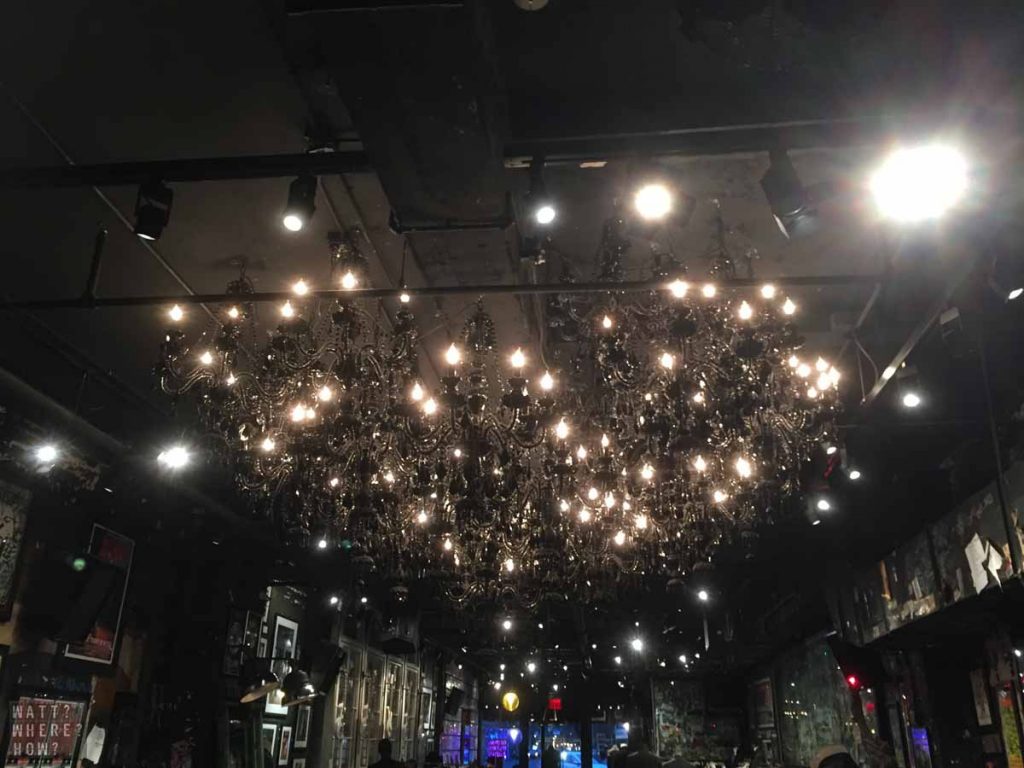
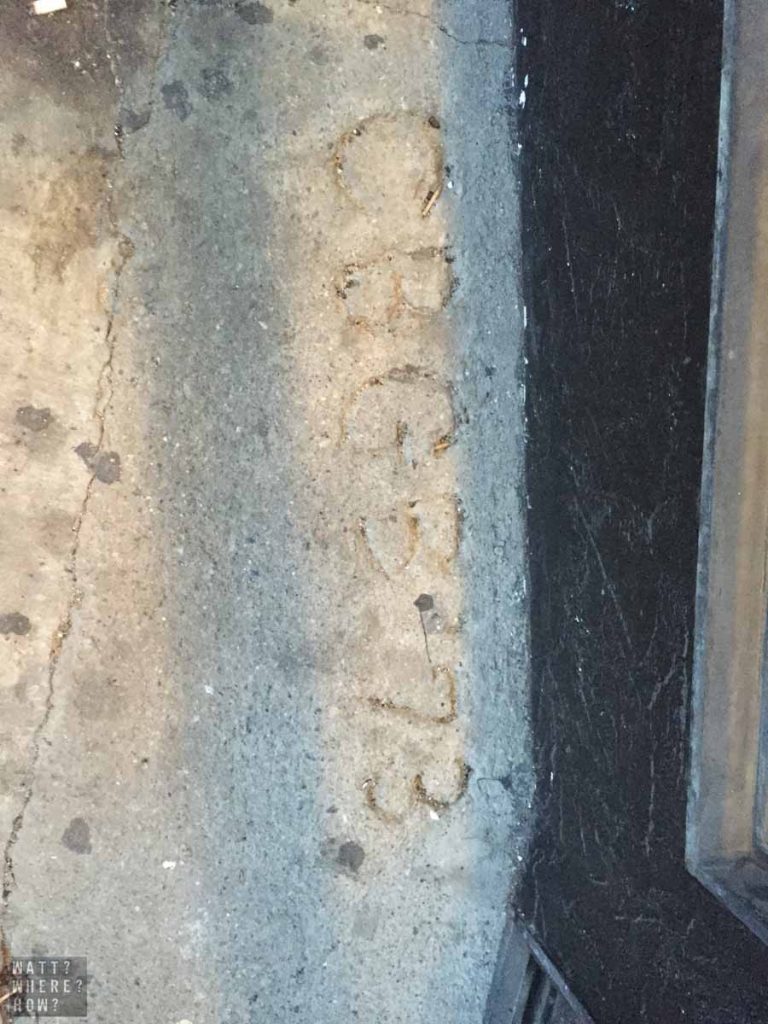



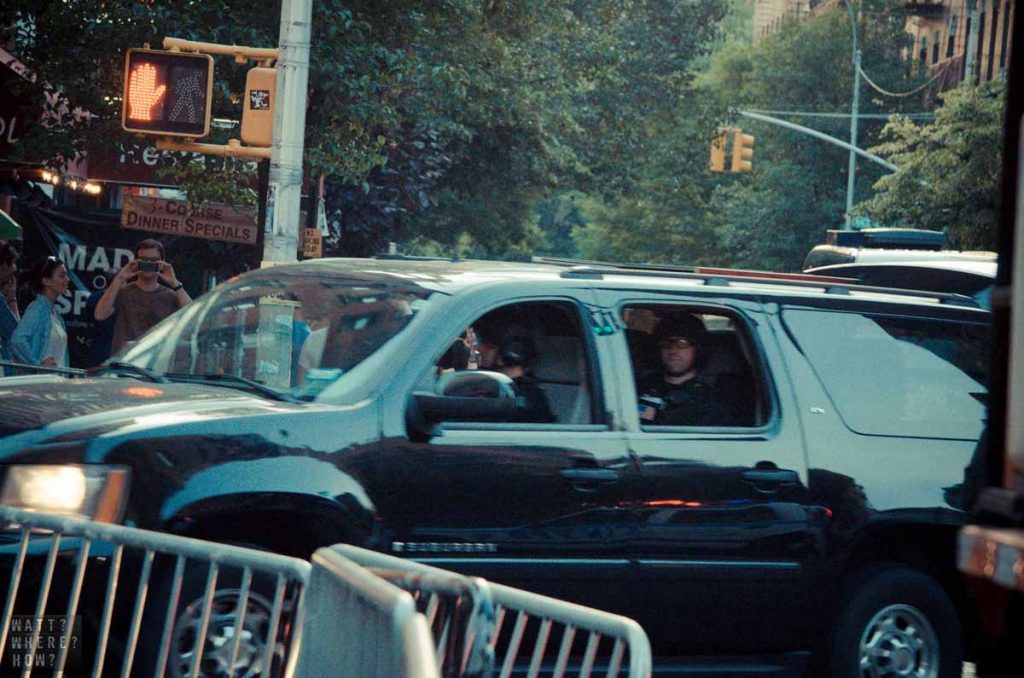

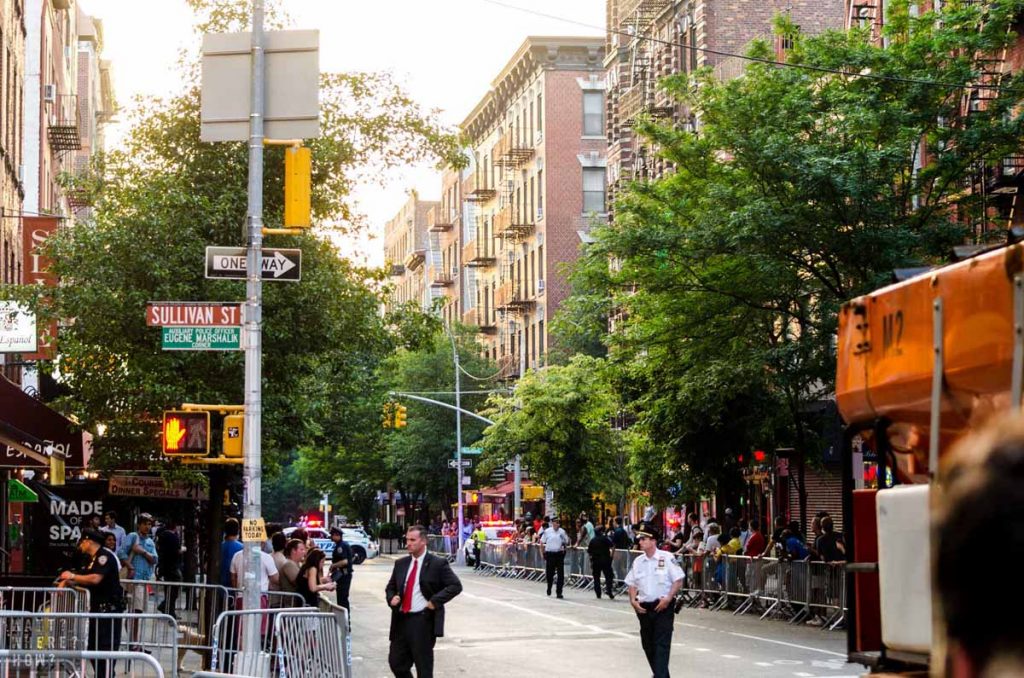








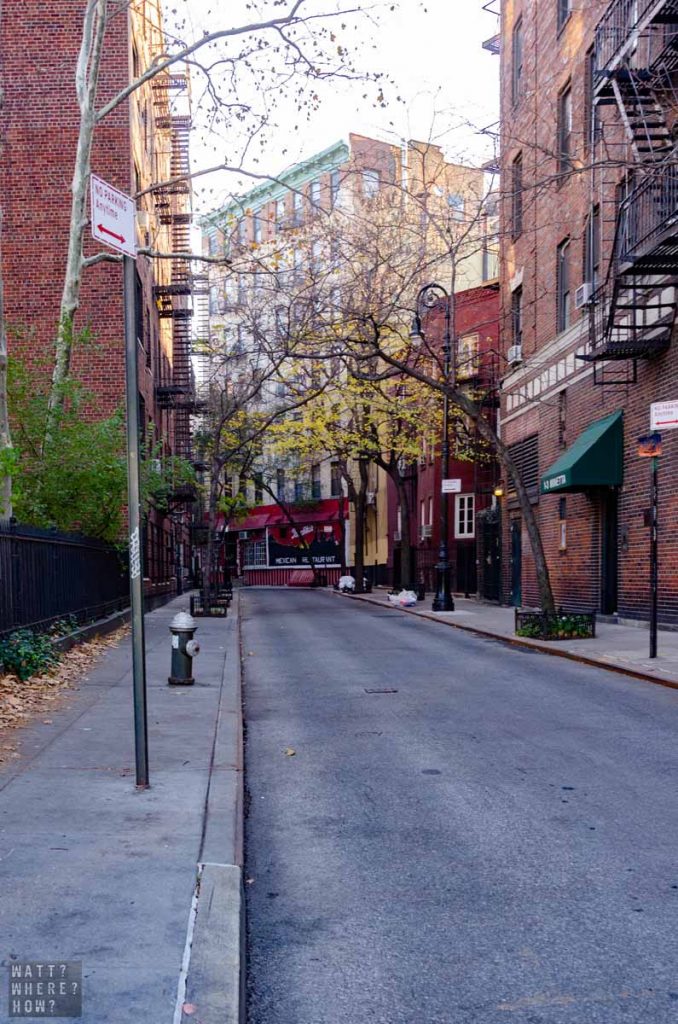
















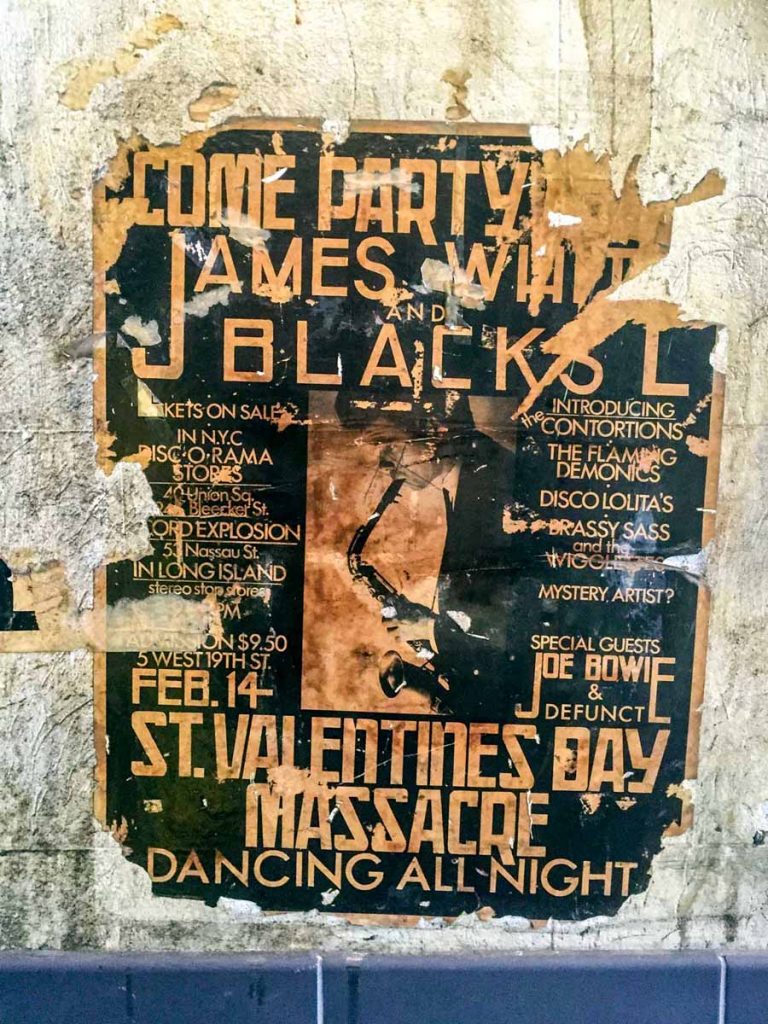
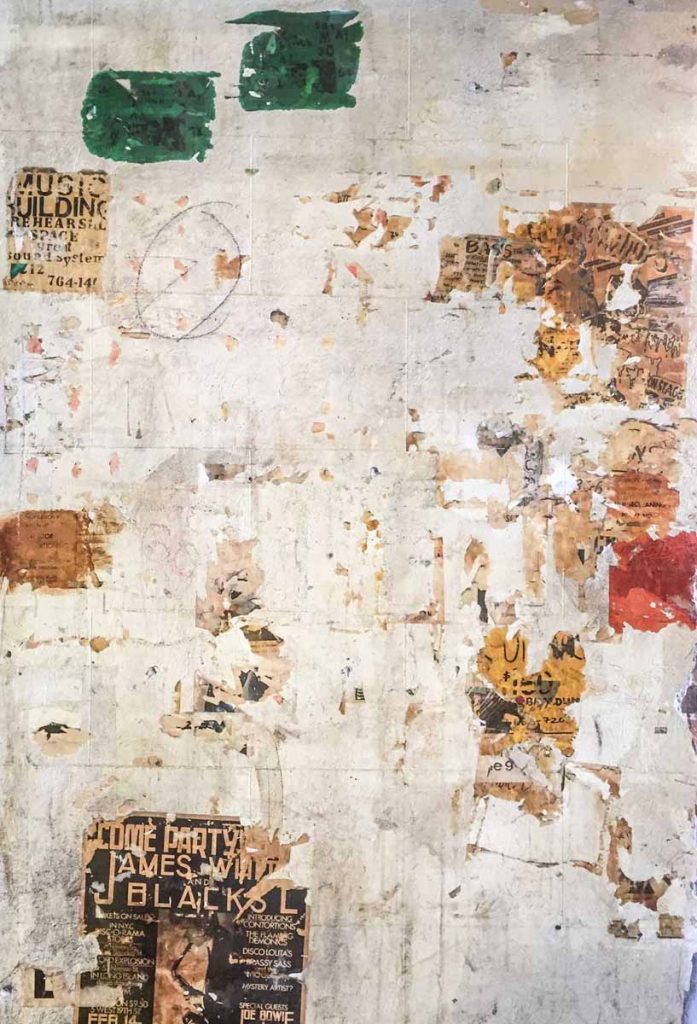


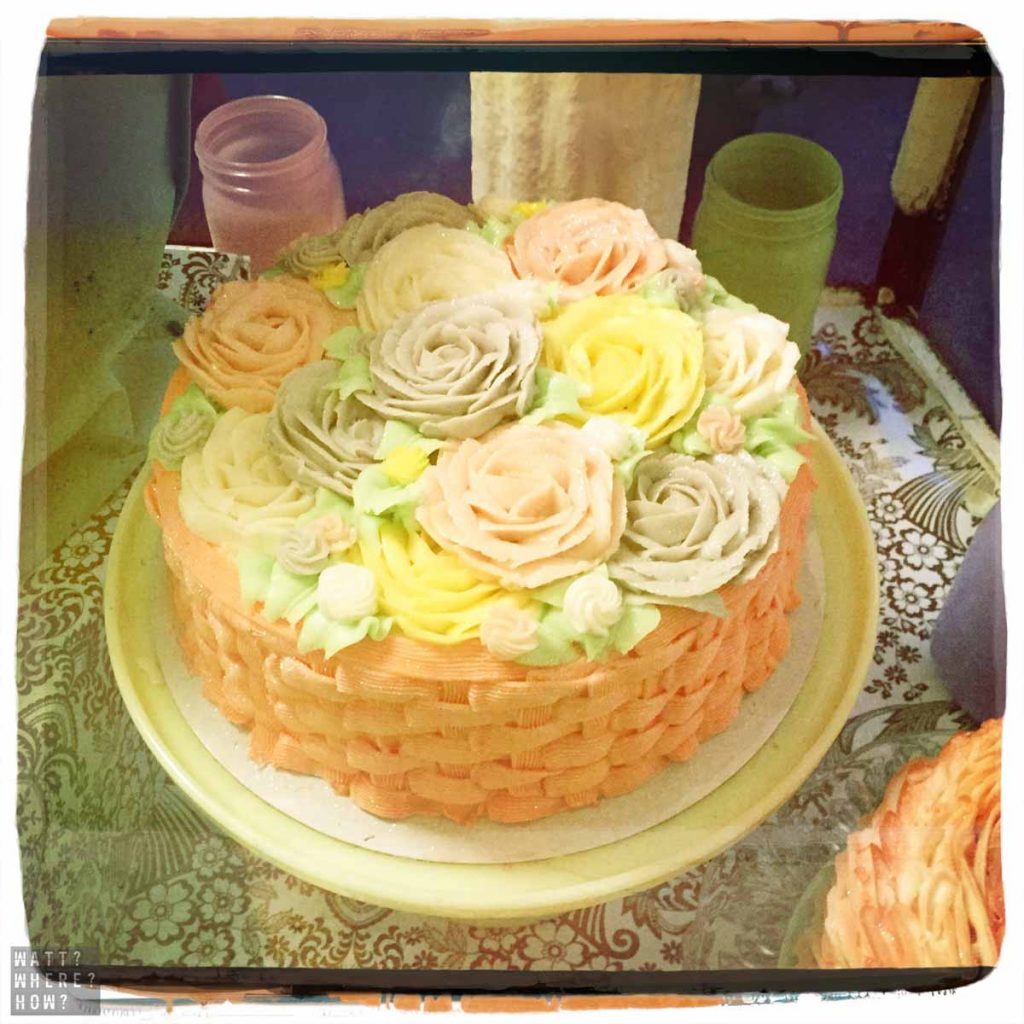









So much to see on just one street! NYC is just such an endless and amazing place to wander.
It’s a street we lived off for 4 years and was always a lovely stroll on the weekends – it’s real NY life.
There’s no shortage of history on this street. So much character too. This article is incredibly well researched. Well done.
Wow! That’s a lot of history for one street! Really interesting to read about though, I’ll have to add Bleecker Street to my places to visit when I get back to NYC 🙂
What a wonderful stroll on bleecker street. Many familiar sights I’ve come across in previous strolls in nyc. Loved the stories though. Those I didn’t l know 🙂
There are many hidden secrets when you dig a little 🙂
What a fascinating post! Reading this really makes me miss living in NYC! I’ve been on Bleeker Street a bunch but didn’t realize most of its history or cool facts. Now I need to plan a visit back and walk this great guide!
Thank you!
What a great street so much history.
Lovev he murials. Can wait to get back one day and see this we had a very quick fire couple of days when we were in New York.
Will certainly save this for reference
New York is like an onion. You can come many times and each visit peels back another layer
Wow, I’m finding out more places in NY! Awesome article, I love to go for a stroll around here, probably listen to some comedy or jazz.
We’re working on a series of street explorations for the village as we lived there for 4 years. There are so many hidden treasures.
Bleecker street was one of our favorites in New York! Of course we made our pilgrimage to the old CBGBs and visited the Overthrow! But we didn’t realize that there was so much history.
There’s so much hidden in plain site. It’s been interesting researching it all. Thanks for checking it out.
Wow that’s an amazing amount of history on that one street! Would be fun to wander along there and check out some of the bars and restaurants!
We hope it springs back to life by the end of the year. So many of the shopfronts are vacant due to the massive decline in tourism, New Yorkers fleeing the city, and people working from home, rather than buying lunches out.